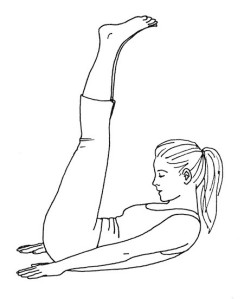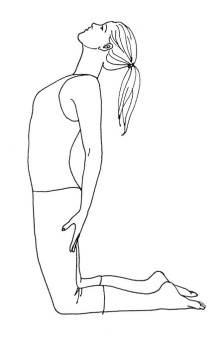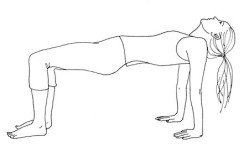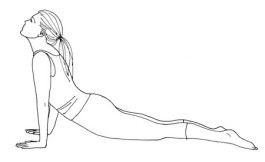by Chris Kilham: The Five Tibetan Rites is a system of exercises reported to be more than 2,500 years old which were first publicized by Peter Kelder…

in a 1939 publication titled “The Eye of Revelation” and later popularised by Chris Kilham’s book, “The Five Tibetans” in the mid 1990s.
The Five Tibetan Rites are also referred to as “The Five Rites”, “The Five Tibetans” and “The Five Rites of Rejuvenation”.
The Rites have been affirmed by a lama and scholar of the Sa skya tradition of Tibetan Buddhism as being “a genuine form of yoga and were originally taken from an authentic Indo-Tibetan tantric lineage, namely a cycle of yantra-yoga associated with the Sadnadapadadharma.”
However, the Five Rites and traditional Tibetan yoga both emphasize “a continuous sequence of movement” (vinyasa), whereas Hatha yoga traditionally focused on a series of “static positions”, quite popular in Western yoga classes today.
Kilham states that these sacred rites have “immense potential value for those who will clear 10 minutes a day to practice.”
The Five Tibetans are sometimes called the “Fountain of Youth,” increasing vital energy and slowing down the aging process.
Once you learn them, you can do these exercises in just 10 minutes to keep in tip-top shape. Since they raise up the energy in the body, it is probably best to do them in the morning, before food – i.e. on an empty stomach.
Caution: if you have not exercises for a long time, begin by practicing just a few repetitions of each ‘rite’ (no more than 10), and build up to 21 repetitions. Listen to your body, not your ego!
Tibetan 1

Children spin around all the time – quite naturally! As adults, we’ve forgotten to do this simple, fun exercise which balances the inner ear.
Stand with your arms outstretched and horizontal to the floor, palms facing down. Make sure your arms are in line with your shoulders. Your feet should be about hip distance apart. Draw the crown of your head up toward the ceiling. Focus on a spot in front of you so that you can count your rotations. Spin around clockwise until you become a little dizzy. Gradually increase the number of spins to 21.
Breathing: Inhale and exhale deeply as you spin.
Tip: If you feel super dizzy, interlace your fingers at your heart and stare at one point in front of you until you come back to centre.
Tibetan 2

You really need a strong core for this. So, if this is too much with the legs straight, bend them so that your shins are parallel to the floor. Extend each leg, one at a time, and lightly touch the floor with your heel(s).
Lie flat on the floor. Fully extend your arms along your sides and place the palms of your hands against the floor. If you have lower back issues, place your fingers underneath your sacrum – or the do the variation explained above. As you inhale, raise your head off the floor, tucking your chin into your chest. Simultaneously lift your legs, knees straight, into a vertical position. If possible, extend your legs over your body toward your head. Then slowly exhale, lowering your legs and head to the floor, keeping your knees straight and your big toes together.
Breathing: Breathe in deeply as you lift your head and legs, and exhale as you lower them.
Tibetan 3

For those of you who do yoga, this is a moving variation of ‘Camel pose’ (ustrasana).
Kneel on the floor with your toes curled under. Place your hands on the backs of your thigh muscles. Tuck your chin in toward your chest. Slide your hands down the backs of your thighs as you draw your shoulders back and your head up toward the sky. Lift from your sternum and slightly engage your glutes to prevent strain in your lower back. Move your head back as if you were drawing a line with your nose on the ceiling – imagine a small cushion is behind your neck to save you ‘crunching’ your cervical vertebrae! Slowly return to an upright position and repeat.
Breathing: Inhale as you arch your spine and exhale as you return to an erect position.
Tibetan 4

This is similar to the yogic ‘table top’ pose.
Sit down on the floor with your legs straight out in front of you and your feet about 12 inches apart. Place your palms on the floor alongside your sitz bones. As you gently drop your head back, raise your torso so that your knees bend while your arms remain straight. You are basically in a table-top position (see image). Slowly return to your original sitting position. Rest for a few seconds before repeating this rite.
Breathing: Breathe in as you rise up into the pose, hold your breath as you tense your muscles, and breathe out fully as you come down.
Tibetan 5

This is like moving from down-dog to up-down in one go.
Lie down on your belly with your palms face down and in line with your bra strap. Press up into an upward-facing dog by curling your toes under, lifting your heart, and drawing your shoulders back. Your arms should be fairly straight, with a microbend at the elbows. Look straight ahead of you, or if you are a little more flexible, gently draw your head back, taking your eyes toward the sky. Then draw your hips up and back, extending your spine, into downward-facing dog pose. Repeat by moving back and forth between downward- and upward-facing dog.
Breathing: Breathe in as your rise up into upward-facing dog; breath out as you push back into downward-facing dog.
If you practice these five positions every day, you will be amazed at how quickly your body starts to respond!








































